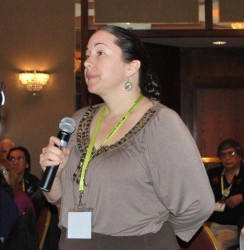Article Origin
Volume
Issue
Year
The Amos Key Jr. Institute had the opportunity to present its e-learning model to delegates at the Chiefs of Ontario Education Conference held in Toronto Oct. 24 and Oct. 25. One of the reasons for the conference, said Gord Peters, grand chief of the Association of Iroquois and Allied Indians, was to bring together leaders and people in the education field to share successes.
Audra Sewell-Maloney, the executive director of the Amos Key Jr. E-Learning Institute located in Brantford, spoke to Windspeaker. What makes our model truly innovative, she said, is that it’s first peoples control over first peoples’ education. It’s our response to the lack of action when it comes to education for our people, she continued.
Sewell-Maloney is Mi’kmaq and has a Bachelor of Aboriginal Education from Brock University. She’s been working in Aboriginal education for 15 years and knows the barriers and challenges faced by Aboriginal children and youth when it comes to education.
Because of this experience, she said, she and Amos Key grabbed onto the idea of the e-learning model when they heard about it. They hooked up with Sunchild in Alberta, a group that developed the model. Sunchild has been delivering the program to Alberta First Nations communities for the past 12 years. The Amos Key Institute has an exclusive agreement to host the program in Ontario.
What makes this program unique, said Gary Donovan, the principal of the Institute, is that we have scheduled classes and there’s a live teacher present who students can interact with. Students can engage with the teacher and with other students while class is in session through a chat room, by typing in questions which appear on the blackboard that all students can then see, or through verbal communication using the microphone they’re all equipped with. All classes are archived, said Donovan, and students can access them at any time.
The other unique feature, said Sewell-Maloney, is the course offerings, particularly Aboriginal languages and Native Studies. The Institute offers courses in Cayuga, Mohawk and Ojibway, with plans to offer more in future. English courses will feature Native authors. When students see themselves reflected in the course content, you get a better engagement with them, she said, and a better chance of successful secondary school completion.
The Institute was set up three years ago by the Niagara Peninsula Aboriginal Area Management Board (NPAAMB) as a private school. NPAAMB covers the cost of tuition for students living in their catchment area. Right now, they have 25 students and they offer courses for grades 9 to 12.
There was a positive response to the presentation at the conference, said Donovan and a lot of interest from First Nations communities. We have to sit down and show people how it works, he said. It’s hard to get your mind around it, that kids can do this instead of getting bused to a regular high school.
Students living anywhere can access this program, said Sewell-Maloney, and I’d like to see it go right across Canada.
- 2230 views

